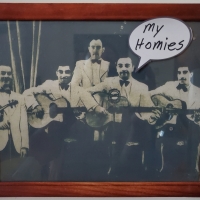DjangoBooks.com
Welcome to our Community!
Categories
- 20K All Categories
- 1.1K General
- 478 Welcome
- 59 Archtop Eddy's Corner
- 146 CD, DVD, and Concert Reviews
- 385 FAQ
- 26 Gypsy Jazz Italia
- 27 Photos
- 207 Gypsy Picking
- 21 Unaccompanied Django
- 15 Pearl Django Play-Along Vol.1
- 17 Gypsy Fire
- 45 Gypsy Rhythm
- 1.4K Gypsy Jazz University - Get Educated
- 131 Gypsy Jazz 101
- 228 Repertoire
- 224 History
- 708 Technique
- 51 Licks and Patterns
- 6 Daniel Givone Manouche Guitare Method Users Group
- 20 Eddie Lang Club
- 1.3K Gypsy Jazz Gear
- 805 Guitars, Strings, Picks, Amps, Pickups and Other Accessories
- 461 Classifieds
- 50 Recording
- 62 Other Instruments
- 18 Violin
- 5 Mandolin
- 22 Accordion
- 7 Bass
- 10 Woodwinds
- 348 Gypsy Jazz Events
- 143 North America
- 110 Europe
- 95 International










Comments
www.scoredog.tv
@Buco A number of Selmer Eddie Freeeman models and tenor guitars were converted to six strings. Many of them were converted by an Italian luthier working in London named Marco Roccia. One of the converted Eddie Freeman models was used extensively by the British guitarist Diz Disley. Disley played with Grappelli quite a bit in the 70s.
The 2 fellows immediately immediately went nuts, and did everything they could to check out the guitar, getting to ready to buy it for hopefully next to nothing. So they arranged a meeting to inspect the guitar.
When they showed up, they opened up the case and lo and behold a REAL SALMIER guitar!!!!
www.denischang.com
www.dc-musicschool.com
I wouldn't read too much into that vid as most of what you're hearing is the 1st generation Barcus Berry pickup (acoustic amplification had come a long way since then!)
But yes, acoustically the larger soundhole does boost some bass and mids so it does sound a little more modern. I'll have a vid up soon.
It's hard to imagine that someone interested in acquiring this guitar, or any vintage Selmer, would not have Charle's book at minimum, and probably have it memorized, but it shouldn't injure anyone too severely if I make reference to it. In the English edition of The Story of Selmer Maccaferri Guitars, there is a bit of text dedicated to Marco Roccia. It states that Roccia worked at Clifford Essex, a London-based instrument making firm, from 1927 to 1977. While there, he is said to have done work on many original Selmers, restoring the more popular models and converting guitars like the Eddie Freeman model. His work is reputed to be "mostly of high quality and difficult for the uninitiated to spot, except where he has stuck on hil label mentioning the 'repair' of the instrument." There are pictures of a converted Eddie Freeman model on page 199, one being a close-up of Roccia's label, which is affixed above the original Selmer label.
And about that Selmer label. We can see in the close-up of the soundhole that it is an "uncut" label, which, according to Charle's research, is the label we tend to see in the Eddie Freeman - you can see a great shot of it inside #338 on page 98, and a bit more detail on page 190, which describes this feature as the "Uncut label used in instruments without soundbox before the appearance of the oval hole, particularly in the Eddie Freeman model."
The 4-string Grand Modèle came out early in 1933, but Charle states it had an impractically narrow neck and a soundbox that apparently did not work well on this model (p.97). It's not absolutely clear - Charle's book is a beautiful book and a must-have, really, but it is not exactly impossible to misunderstand - but it sounds like the "improved" Eddie Freeman model came out later that same year, featuring a wider neck and a simpler body free of the soundbox - but still a D-shaped soundhole. I am gleaning from the text that very few of the 4-string Grande Modèle guitars were made, over a hundred of the Eddie Freeman models were built, and that production of these four-string models probably stopped in 1934. And, of course, because of the temptation to convert them for 6 strings, they are rarely seen today.
There was also the four-string Tenor, but the body is much smaller on that model, too small to have become the '33 conversion here.
It would be fascinating to know exactly what was done in the conversion process of this guitar. The Roccia conversion pictured in Charle's book (p. 198) preserves the original D-shaped opening, and has an extension on the fingerboard. This guitar has the same extension. How did he do that? Where did he get that neck? Did he make it? How about the Selmer logo? And on this guitar, the top, the binding (which looks untouched), the rosette - that soundhole (which together suggest a new top) - all very curious.
In any case - speaking of which, look at the beautiful case! It's in great shape - it's a wonderful guitar. I'm sure many of us are curious to hear it, and read more about it.